3 ECS Key Application Areas
3.1
Mobility
Our mobility is currently in a fundamental phase of change. Mobility is faced with great challenges and at the same time offers enormous potential to help solve essential problems of our world: global warming because of CO2 created by our society (Green Deal), an ageing society with special needs for an easy and accident free mobility. Therefore our mobility is subject to a radical ecological (as well as political) change towards its contribution to the European Green deal as well as towards an automated and/or assisted mobility. The interaction with digitization, urbanization, connectivity and individualization increases the demand for innovative solutions that are based on people's needs like never before. It is important to accelerate the combination of these two developments in a meaningful way in the future.
Mobility is a basic human need and Europe’s mobility industry is a key contributor to it. The automotive sector alone provides employment, both direct and indirect, to 13.8 million Europeans, representing 6.1% of total EU employment. 2.6 million people work in the direct manufacturing of motor vehicles, representing 8.5% of EU employment in manufacturing146. The automotive sector is also the driver for innovation in many other mobility sectors in Europe, including aerospace, maritime and rail, but also in other sectors as e.g. farming and industry (advanced robotics).
During the COVID crisis individual transport was largely favoured due to a basic user need, a clean and safe personal environment. Only cars can offer such an environment today. On the other hand, the current energy crisis demands to reduce energy usage also in mobility. Shared and new mobility concepts will play an increasingly important role. A major challenge will be to combine this need for individual space in a public or shared mobility, which reduces the energy consumption of mobility at least by more than 20% compared to today without setting CO2 free or causing more accidents than experienced drivers.
The first societal challenge, known as the European Green Deal, is at the forefront of the EU’s priority list. As automotive traffic is currently contributing approximately 14% of global CO2 emissions, CO2-neutral mobility requires alternative mobility systems (battery or H2 fuel cell based wherever possible, also synthetic CO2 neutral fuels are necessary in some applications) for automotive vehicles, ships and flying equipment. It needs also a smart energy-production, intermediate energy storage, energy transmission and charging infrastructure. This is an important part of the energy transformation in Europe. Existing infrastructure must be optimised or replaced, wherever possible the use of existing mobility infrastructure is envisioned.
The ECS and the key technologies they enable (sensors, semiconductors, embedded AI enabled software in integrated intelligent systems) are essential building blocks for these new CO2 neutral and energy efficient mobility solutions including the required energy transformation. But as the microelectronics based computers, sensors actuators and communication equipment uses energy itself, therefor also are more energy- and cost-efficient electronic and optoelectronic components, interconnected intelligent systems and (AI-based) embedded software often connected to powerful AI enabled backend cloud systems (e.g. traffic control systems) are required.
This ECS-SRIA Chapter on mobility is aligned with the proposal for the partnership “Towards zero emission road transport” (2Zero) programme by Horizon Europe to achieve carbon-neutrality in road transport by 2050. There are plans to continue and strengthen this cooperation between 2Zero and the ECS community.
The second societal challenge focuses on the usage of smart perception, safety and automated mobility solutions and services to provide safe and comfortable inclusive mobility that is also suitable for the elderly as well as people with special needs. Research, development and innovation (R&D&I) of embedded AI-based software, sensors and electronic components and systems provide the core of automated on- and off-road vehicles, ships, trains and airplanes. A special focus requires validation of the safety and reliability of the automated mobility systems in all traffic and environmental situations as there are currently no adequate methods and tools available. Digital twin technology will be crucial to evaluate, develop and update/maintain real-life vehicles. Therefore, the ECS-SRIA Chapter on mobility is also closely aligned with the proposal for the partnership “Connected, Cooperative and Automated Mobility” (CCAM) under Horizon Europe.
Additional key aspects of the contribution by the ECS domain to the future of mobility are increasing user value, security, privacy protection features, affordability and human interaction. Particularly in urban areas, intermodality and technologies supporting the shared principles will be crucial.
The Green Deal and digitalisation are significantly influencing the ECS-SRIA in the mobility domain: the reduction of CO2 and other emissions, and ensuring an inclusive safe and secure mobility for an ageing global society. This leads to five challenges in R&D&I for mobility.
Five Major Challenges have been identified in the mobility domain:
- Major challenge 1 (climate and energy): Enable CO2-neutral (electrified or sustainable alternative fuels based) mobility (passenger cars, trucks, airplanes, ships, bicycles, tricycles, wheelchairs, drones, and mobile off-road machinery (e.g. for smart farming or mining) and required energy transformation.
- Major challenge 2 (digitalization): Enable affordable, automated and connected mobility for passengers and freight on road, rail, air and water.
- Major challenge 3: Modular, scalable, re-usable, flexible, cloud-based, safe&secure end-to-end software platform (operating system and middleware) able to manage software-defined mobility of the future, sometimes labelled as “CAR-OS”.
- Major challenge 4 (validation): Provide tools and methods for validation and certification of safety, security and comfort of embedded intelligence in mobility (using also digital twins).
- Major challenge 5 (real-time data handling): Achieve real-time data handling for multimodal mobility and related services.
The results of R&D&I from challenge 1 will be used in green CO2-neutral vehicles of all kind, some of them integrated into the 2Zero EU partnership, and therefore roadmaps and research programmes are (and will be) aligned. The SRIA of the private public partnership CCAM activities working on “Connected, Cooperative & Automated Mobility” is well aligned with this SRIA in the major challenges 2 to 5 as the key digital components, tools and systems described in this SRIA are essential building blocks in the challenges in CCAM. The outcome of the research on the challenges described here will used in partial or fully automated vehicles for the CCAM EU programme. Therefore, roadmaps and research programmes are of 2ZERO, CCAM, KDT and BDVA are (and will be) aligned.
3.1.3.1 Strong contribution to CO2 neutral Mobility
Mobility is at the heart of European lifestyle and its economy. Efficient transportation systems are more important than ever, and also help to consolidate the European Union and make it more cohesive. However, the promise of freedom offered by road transport is viewed in sharp contrast to a range of concerns about its effect on safety, health and the environment. Therefore, transport and mobility systems are in the process of a fundamental transformation towards a vision of sustainable, CO2 emission neutrality that involves efficient, inclusive and seamless solutions. CO2 neutral mobility is mainly using electrical energy, therefore mobility is also embedded in the European Energy Transformation.
3.1.3.2 Contribution to inclusive mobility
An additional societal aspect is an inclusive mobility: for decades, disabled people have promoted a universal approach to the design of transport systems to make them more accessible and useful for everybody. In view of the Covid-19 pandemic, this focus on human factors of transport innovation is expected to increase; it will particularly call for smart and intelligent mobility systems enabled by ESBS (electronic and software based systems).
3.1.3.3 Strong contribution to fatality free mobility
Automation and advanced driver assistance system have to contribute to a continous reduction of fatalities of passenger and improve transportation by different modalities.
3.1.3.4 Protect strong position of European automotive industry
Mobility is not only a visible expression of Europe’s economic and societal prosperity, it is also an important source of that prosperity. According to Europe’s car manufacturers and transporters, the automotive sector employs around 12 million people (approximately 2.6 million directly and close to 10 million indirectly), contributing 16% of the EU’s GDP147. Currently, the transportation sector is undergoing a fundamental and complex transformation across all modes.
3.1.3.5 Convergence of automotive and energy eco-system
Electrified cars are getting integral part of the European energy eco-system. Vehicle batteries will used as intermediate storage for electrical energy (bidirectional charging). Vehicles will even produce electrical energy (photovoltaic panels on car roofs or from heat-pumps), which will be partially send to the grid. This has severe consequences for the requirements of the electrical and software systems in the vehicles.
The operation hours over the intended lifetime of the vehicle is significantly increasing. Up to now, the lifetime for the components of vehicles are about 8000 h, which reflects the hours a typical vehicle is driving. As the vehicles will get now integral part of the grid, the operating hours are hours of a year multiplied by the expected lifetime years of the vehicle. This means an increase of lifetime of the effected components (as in the bidirectional charging or the necessary embedded control software) by a factor of 5 to 15. This convergence of the automotive and energy eco-system creates also large challenges in the validation. It requires significant use of digital twins in the simulation, as it is not possible to do duration testing over 10 years prior release of a component.
3.1.3.6 Digitalization in maritime industry
The EU’s maritime industry is characterised by high value-added expertise, rapid innovation, rigorous safety standards and a leading position in green technologies. A strategy to further build on these strengths will ensure that the EU retains its competitive position in the global maritime industry, and reaps the rewards in terms of jobs and wealth creation.
3.1.3.7 Digitalization in aerospace and rail industry
The current leading position of the European aerospace and rail industry will require a further shift to the greater autonomy of planes, trains and infrastructure, and increased trustworthiness of radio and other communication technologies. Therefore, it is also strongly dependent on progress in key digital components and AI-based real-time software.
An important priority of the European Commission in its Communication on the European Green Deal is ‘’accelerating the shift to sustainable and smart mobility’’. This will require a strong boost to multimodal transport, automated and connected multimodal mobility, a ramp-up of the deployment of sustainable alternative transport fuels and less polluting transportation, especially in cities.
3.1.3.8 Semiconductor industry
Europe is ranked number one in automotive semiconductors. In the automotive value chain, Tier 1’s and original equipment manufacturers (OEMs) are also top global players and intend to gain further market share through close collaboration with semiconductor and embedded software leaders in Europe.
The electronics components and systems (ECS) community will contribute substantially to these tasks by using new technologies, components and systems to target the following topics:
- Autonomous vehicles
- Electrified CO2 neutral vehicles
- Over the air (OTA) updates
- New mobility concepts to reduce number of energy usage (e.g. mobility as a service)
Electrification of vehicles and development of powertrains for carbon-free energy carriers. Enabling technologies come from the European ECS industry – for instance, energy-efficient devices, power electronic components and systems, energy (e.g. battery) management systems, and embedded software solutions for power management.
Autonomous vehicles and coordinated mobility to make traffic more efficient and thus reduce pollution by new electronics architectures, smart and connected sensor systems, AI-based real-time software, higher-performance in-vehicle controllers and networks, as well as connectivity devices and advanced embedded software solutions.
Rapid advances in AI and edge computing will ensure Europe can produce a step change in these areas. Autonomous driving, mobility and logistics are high-profile applications where the use of AI technologies is growing very rapidly, affecting both society and industry directly. The European transport industry is being revolutionised by the introduction of AI (combined with electric vehicles). However, AI applications in transport are very challenging, as they typically involve highly complex environments, a large number of possible situations and real-time, safety- relevant decision-making. Leading IT companies in the US and China in particular are providing a challenge to European industry in these areas, and significant effort will be required to safeguard the leading position of the European automotive industry. Hence the development of digital twins is a crucial element to further develop and update all types of vehicles interacting with the environment, with each other and with the cloud.
Revenues related to autonomous driving and connected cars are expected to boom (see Figure F.45), with safety applications (e.g. automatic collision detection/prevention) expected to reach USD58 billion (up from USD18 billion in 2017), autonomous driving (e.g. distance/park/motorway assistant, pilot, traffic sign detection/ recognition) set to reach USD55 billion (up from USD14 billion in 2017) and connected services expected to reach USD43 billion in 2022 (up from USD21 billion in 2017).
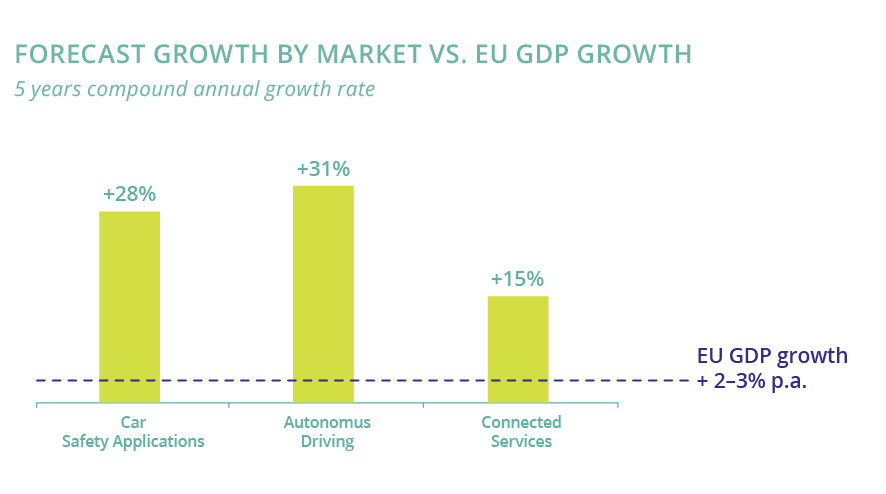
There will be a need to more intensively monitor, interact with, and update the car remotely. Software upgrades need to be done over-the-air (OTA). Future cars need semiconductors longer lifetime than the lifetime of mechanical car components as cars are always connected , mechanical components are only active during drivind. Hence it is needed to predict the end-of-life of the electronic components and to replace them on-time before the car breaks down.
3.1.3.9 New resource optimized mobility modes
New means of transport systems and interaction among different providers (public/private), including other transport modes (multimodal transport for passengers and goods), will be enabled through further development of new and harmonised vehicle-to-everything (V2X), logistics operation software, traffic management devices and guidance systems to enable mobility-as-a-service (MaaS). Easy access to these systems for users will guarantee the highest standards of privacy to avoid potential impacts caused by the general data protection regulation (GDPR) since information (about origin, destination, financial information, etc.) needs to be shared. Software drives tomorrow’s mobility and transport innovations.
3.1.3.10 Protect leading position in automotive industry
All of the four mobility megatrends (electrification, autonomy, connectivity, shared mobility) highly rely on leading-edge software. Especially the car industry needs to face this new software-driven value chain. A typical modern vehicle likely has a software architecture composed of five or more domains (body, chassis, ADAS, etc.), together comprising hundreds of functional components in the car and in the cloud. Currently, OEMs are constructing a complex software architecture with various software providers ending up in a complex scenario with a broad set of development languages, operating systems, and software structures/elements. Up to now no single software platform (middleware) on the market can meet the requirements of CCAM. The domain-based hardware architecture is rapidly evolving towards a zonal architecture, where the software architecture, implementation and the corresponding development environment needs to be compatible. A middleware has to separate the hardware layer from the software layer and allow faster time to market to standardized interfaces.
3.1.3.11 Sovereignty for European mobility industry
The work on the mobility challenges will help to protect the sovereignty in the digital heart of mobility devices (passenger cars, trucks, etc.). Currently Europe has a leadership in the embedded software in all kind of vehicle. This is endangered by the push of the big global IT companies into the embedded IT systems of the vehicle. Europe has to protect its leadership in creating a next generation of middleware and operating systems prepared for the significantly increased complexity of CO2 neutral automated and assisted vehicles.
- Major Challenge 1: Enable CO2 neutral (electrified or sustainable alternative fuels based) mobility and required energy transformation.
- Major Challenge 2: Enable affordable, automated and connected mobility for passengers and freight on or off road, rail, air and water.
- Major Challenge 3: Modular, scalable, re-usable, flexible, cloud-based, safe&secure end-to-end software platform able to manage software-defined mobility of the future.
- Major Challenge 4: Provide tools and methods for validation and certification of safety, security and comfort of embedded intelligence in mobility.
- Major Challenge 5: Achieve real-time data handling for multimodal mobility and related services.
3.1.4.1 Major Challenge 1: Enable CO2 neutral (electrified or sustainable alternative fuels based) mobility and required energy transformation
Worldwide efforts on the regulation of pollution and CO2 emissions are leading to a strong increase in the electrification of vehicles, either with batteries (“battery electric vehicles”, BEVs), “hybrid electric vehicles” (HEVs) with petrol or diesel engines, or using fuel cells. Possible scenarios developed by BIPE149 in France are shown in Figure F.46. In particular, depending on the evolution of regulations, the split could be significantly different between the various technologies. However, the most probable scenario is that of the “Green Constraint”. But currently there are discussions about bans of fossil fuel engines even as soon as 2035, therefore the data are expected to change.

F46 - Sales structure of cars 2018 and 2035 (4 scenarios) (Source: PFA France 2018)
Looking in more detail at the difference between low voltage systems (particularly 48V) and high voltage systems, there are six important observations that can be made:
- All new cars in Europe will be electrified by 2035.
- The proportion of electrified cars in the world will reach about 70%.
- Low voltage systems will take about 60% of the market, with high voltage the rest.
- Around one-third of the market will require on-board chargers for high voltage in the range 400–1000V.
- Fuel cell electric vehicles will still play a significant role in long-haul trucks as well as trains as well as in airplanes, ships and drones by 2035.
The expectation is that the overall electrification scenario will lead to massive changes in the supply chains and the distribution of competences. In the field of power electronics, Europe is now in an excellent position and its industry needs to organise itself to ensure it benefits from the opportunity.
- Modular, flexible and scalable platforms and electrical/electronic (E/E) architectures.
- Hardware upgradability.
- Reconfigurable and adaptable software architectures.
- Software updateability (including over-the-air, OTA).
- On-board technologies (devices, actuators and sensors, virtual sensors).
- Embedded intelligence (AI-powered and AI-enabled intelligence):
- Control software, real-time capable algorithms.
- Fault-tolerance, fail-operational concepts.
- Cognitive vision.
- New control software is required to take full advantage of new solid-state batteries so that they have an extended lifetime, as well as their driving range in vehicles. As lifetime is key for batteries used in mobility systems, tools for accelerated lifetime testing, diagnostic systems as well as control systems that can extend the lifetime and limit degradation are essential for the success of electrified green mobility. New power electronics based on silicon carbide (SiC) and gallium nitride (GaN) devices are needed to ensure energy-efficient operation. AI and model-predictive control algorithms, supported by high-performance, multi-core, real-time operating systems, has to offer the necessary intelligence based on ultra-low power/high-performance control units.


- Similarly, advanced control methods for fuel cell-based vehicles (mainly in trucks and buses) that both minimise degradation and maximise efficiency are crucial. For example, predictive control schemes that take into account forecasts on e.g. route, traffic, weather, etc. are necessary. State-of-health monitoring systems (virtual sensors) as well as adequate new sensors to measure the operating conditions within fuel cells without negatively influencing their operation are required. Of equal importance are dynamic test systems that allow to predict fuel cell / battery degradation and optimise their lifetime and efficiency. Such systems will be new essential base components from ESBS. Over-the-air update strategies to improve degradation models (based on real driving data) and also optimize the vehicle operating strategy allow to implement e.g. adaptive energy and thermal management strategies which will extend component lifetime.


- For both electric battery and fuel cell-based mobility, new safety concepts using (AI-based) IoT diagnostics must ensure the safety of these systems, especially in accident situations.
- Low environment impact of new technologies in terms of energy consumption at production, deployment, use and end of life treatment.
- Reduction of sensible materials such as rare earth materials.
- Recyclability.
- Efficient and fast charging and filling of alternative energy into green vehicles is another critical research topic.
- The conversion of renewable energy into green energy as electricity stored in vehicles or H2, or alternative fuels, also need efficient electronics with real-time embedded software communication with the power grid to minimise the need of new charging/filling infrastructure, which is one of the cost drivers limiting the speedy success of green mobility.

- Smart Battery: with the batteries in electric vehicles being the most expensive and life-time critical parts, future battery systems will be equipped with sensing technology, intelligence and communication systems to monitor their own health and record their lifetime dataset. This enables better usage of the batteries as well as optimized second life concepts.
- Power electronics (fast-switching elements, wide bandgap materials, low power, etc.)
- Significantly extended lifetime of automotive semiconductor components due the convergence of the automotive and energy eco-system. It requires use of digital twins in the validation process.
- Predictive diagnosis and maintenance (including recovery strategies, fault detection and localisation, surveillance sensors, etc.).
- Cloud/edge/fog processing approaches.
- Distributed logistics systems for smart farming, movers and shuttles.
- Standards, including communication and interoperability standards, electromagnetic spectrum and bandwidth management, charging units, car access systems, etc.
- Reliable and human-like perception systems.
- Tailored ESBS-enabled solutions for disabled people (supporting robots, smart wheelchairs, etc.).
- Proof of robustness and trustworthiness of architectures and quantification of the operational risks.
- Collaborative and self-organised multi-agent systems, e.g., in logistics applications also covering cooperation between land and air vehicles.
- Bio-inspired transport solutions and systems.
Digital innovation is key to ensuring inclusive mobility for persons and goods by providing mobility access to all, with a focus on special needs, by reaching 90% of the EU population compared to the current 60%. As targeted by CCAM, this can be achieved through assisted vehicles by 2050.
By 2050, 67% of the population is expected to live in urban areas. As cities become bigger and smarter, this trend will lead to new opportunities for tailored and specialised vehicle design specific to urban users, including the needs and operations of commuters, as well as ride-hailing and last-mile delivery.
New vehicle concepts and ESBS-enabled architectures should lead to flexibility, scalability, and modularity - while featuring safety, security and reliability - to ensure urban-readiness (appropriate range, compatibility with charging infrastructures, ease of parking and operations, etc.) in all kinds of urban and suburban areas, most likely with different implementation levels of infrastructure and smart technologies. Additionally, it is assumed that these vehicles will not have to be designed for high-speed operation and long range and can easily be charged sufficiently fast and comfortably to meet the daily needs of urban and suburban mobility usage scenarios. This aspect may also include sharing concepts, and consideration should also be given to use by the elderly and disabled.
Another important aspect is the need for reliable and efficient wireless communication technology combined with different types of sensing systems to achieve efficient traffic and increase safety as well as reduce fatalities. This further set requirements on components and systems for wireless communication to achieve ultra-high reliability and resilience as well as to meet challenging performance and latency demands. ![]()
The challenge targets the following vehicle categories:
- Passenger cars (including light four- wheelers, M1/M2 category).
- Trucks (including power-driven vehicles having at least four wheels used for the carriage of goods (N1), agricultural and forestry tractors, and non-road mobile machinery (T)).
- Ships.
- Airplanes.
- Motor vehicles with less than four wheels (L category).
- Off-road vehicles (G).
- All kind of unmanned air vehicles (such as drones).
- All kind of manned light air vehicles.
- Special-purpose light vehicles (air, land, water).
This will have the following impact on European society:
- Urban personal, light personal and freight mobility (including innovative micro-vehicle designs suitable for urban/suburban commuters’ needs, with the option for usage within shared mobility schemes. Such micro-vehicles would also be capable of interfacing with urban collective transport systems (i.e. easy access to buses, trams and trains for last-mile transfers to achieve full intramodality)).
- Light and flexible multi-passenger vehicles (e.g., collective or individual, owned or shared up to M1 category) with robust safety measures for passengers and vulnerable road users, and including specific features to facilitate shared use such as autonomous-capable vehicles with automated relocation to charging points or areas with insufficient vehicle density.
- Log-haul and right-sized vehicles and tailored ECS for commercial uses, such as for long distance, last-/first-mile delivery, construction and maintenance support, which are suitable for urban scenarios.
- Connected and automated mobile machinery to optimise harvesting and reduce accidents.
3.1.4.2 Major Challenge 2: Enable affordable, automated and connected mobility for passengers and freight on or off road, rail, air and water
Europe has the vision of fatality free mobility for all citizens. This is important to provide seamless mobility for an aging society. The European transportation industry has therefore to strengthen their leading position to provide sustainable solutions for safe and green mobility across all transportation domains – automotive, avionics, aerospace, maritime (over water as well as under water transport) and rail. Their competitive asset is a well-established expertise based on developing complex electronic components, cyber-physical systems and embedded intelligence. Nevertheless, a number of challenges in terms of autonomy, complexity, safety, availability, controllability, economy and comfort have to be addressed to harvest the opportunities coming from increasingly levels of automation and related capabilities.
The overall vision is to realise safe and secure, always connected, cooperative and automated transportation systems based on highly reliable and affordable electronic components and systems of European origin, as well as on technologies that offer new types of interaction between humans and machines.![]()
![]()
One of the key motivators is to reduce the number of road fatalities and accidents caused by human error to zero by 2050, as well as in ensuring that no additional road fatalities are introduced through automated transport while bringing validation costs down to 50% of development costs from the current 70–80%. Key Digital Technologies will be developed to support the CCAM public/private partnerships (PPPs) in these ambitious goals. No single organisation will be able to capture these tremendous efforts in research and development. For Europe to maintain a leading position, it is therefore necessary to establish collaborations in and across industrial domains, learn from operational field data, and jointly drive the required strategic actions.
Also, in the waterborne transport sector ships will become fully connected across the globe. Remote monitoring of vessels is already possible, allowing for condition-based maintenance. Building on increasing onboard automation, the remote operation of vessels will become possible, eventually moving towards full autonomy for vessels. The wider use of unmanned autonomous vessels (UAVs) – either aerial, underwater or on the surface – will increase the flexibility and energy efficiency of operations. ![]()
![]()
Connected, cooperative and ultimately automated mobility and transportation is seen as one of the key technologies and major technological advancements influencing our future quality of life. ESBS will enable different levels of partial, conditional, highly and fully automated transportation, posing new challenges for traffic safety and security in mixed scenarios where vehicles with different automation levels coexist with non-automated vehicles. Both development approaches – evolutionary (the stepwise increase of automation level: “conversion design”) and revolutionary (Society of Automotive Engineers, SAE, level 5: “purpose design”, e.g. a people mover in a structured environment) – should be covered, as well as cross-fertilisation with other industrial domains such as Industry 4.0. Cross-fertilization between automotive and 5G evolution and 6G is important to ensure a reliable and resilient communication needed in next generation mobility as described before.
As the proportion of electronics and software, considered as a percentage of the total construction cost of a vehicle increases, so does the demand for the safe, secure, reliable and unhackable operation of these systems. In addition, privacy protection is a key element for car owners and drivers/operators. These requirements demand fail-operational technologies that deliver intrinsically safe operation and dependable fall-back position from component to subsystem, and provides a solution for problems in interaction with the cloud. This requires new developments in terms of multi-core-based platforms and sensing devices, combining advanced sensing in harsh conditions, novel micro- and nano-electronics sensors, advanced sensor fusion and innovative in-vehicle network technologies. ![]()
![]()
![]()
Key elements of ESBS for cars that need to be developed are shown in Figure F.47.
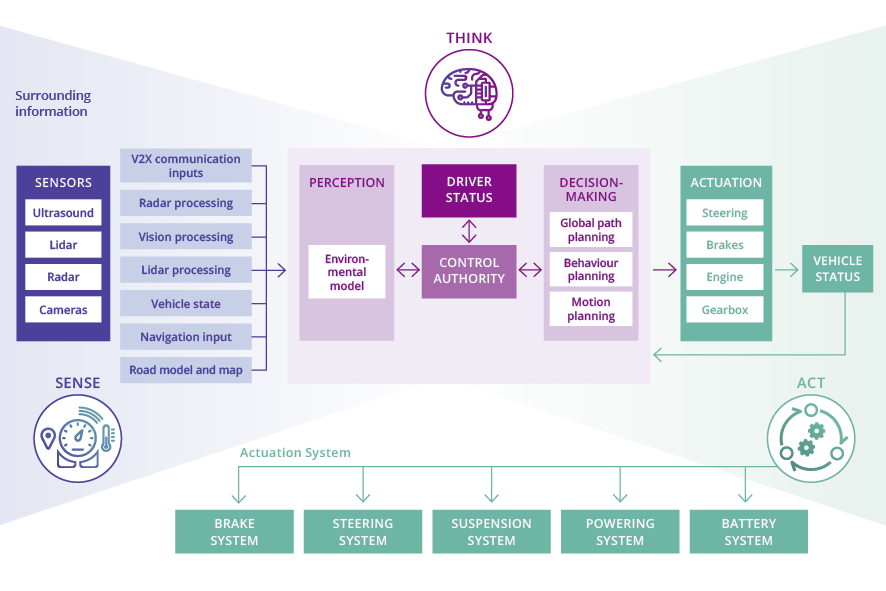
The following research, development and innovations areas and their subtopics have been identified:
- Dependable and affordable environment perception and localisation sensors, and V2X communication. Attention should be paid to sensor interference, more in particular the robustness of sensors to environmental conditions, to interference by other sensors and to malicious interference.
- Integrated sensing and communication systems to further evolve towards fully automated transport and safeguarding VRU’s (Vulnerable Road Users) in all type of traffic situations.

- Centralised service/function-oriented hardware/software architectures, including open APIs, for vehicles, ships, trains that are supported by the cloud and edge computing via 5/6G.
- Dependable and reconfigurable hardware and software, including remote access and Over-The-Air (OTA) software upgrades.
- Hardware and software platforms for control and higher performance in-vehicle networking (up to 25Gbit/s) units for automated mobility and transportation (including support for AI) – e.g. IoT integration platforms for automated and connected environmentally friendly vehicles.


- New developments towards higher performance and efficiency. These are also required to ensure the reliability and safety of the power electronic components and systems for the drivetrain and charging systems, as well as for steering, break/suspension/air condition control in automobiles, trains, ships and flying equipment.
- Trustworthiness of vehicles’ data.

- Interaction between humans and vehicles.
- Active safety systems.
- Vehicle hardware/software to improve comfort in parallel with safety.
- (Predictive) health monitoring and lifetime analysis for the perception and control systems (including all required sensors, V2X systems and localisation systems) and AI components of (highly) automated vehicles used in the operational phase.
- Connected maritime systems and automated transport.
- Smart and autonomous ships.
These requirements result in completely new hardware and software architectures for the control systems due to exploding sensor data volumes as well as new power saving hardware and software components. This requires a new decoupling from hardware with drivers and operating system, from the application components adaptive AI based routing and control algorithms, multimedia components and many more. For these motivations, Major Challenge 3 was introduced to create a common middle ware architecture and implementation.
3.1.4.3 Major Challenge 3: Modular, scalable, re-usable, flexible, cloud-based, safe&secure end-to-end software platform able to manage software-defined mobility of the future
Today’s mainly hardware-defined cars are rapidly transforming into software-defined transportation platforms. Currently, OEMs and their suppliers are developing automotive software modules in isolation ending up in a complex software architecture which does not scale at all. The following figure (McKinsey and Company) illustrates the state-of-the-art how proprietary platforms are built at present. Even though integration among different domains and vehicle systems is essential to unlock new use cases, companies are currently missing an end-to-end platform to easily connect everything together.
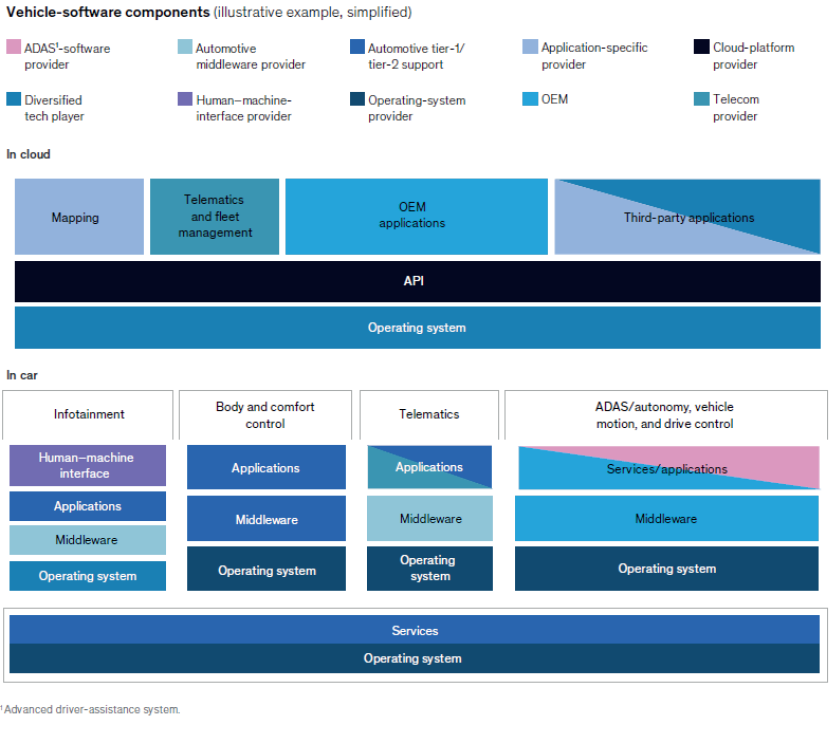
Currently automotive software developers working on different software stacks across a vehicle do not coordinate their activities on a regular basis. Furthermore, it is difficult to align software updates and patches across modules. Because of the rapid transformation to software-defined vehicles (driven by new vehicle functions, features, properties), the automotive industry is facing a widening and unsustainable gap between software complexity and productivity (see Figure F.49 below). To succeed in this dynamically changing environment and to be globally competitive, companies need to minimize (or at least limit) the complexity by reducing the effort required to develop and maintain software. Consequently, the current software operating model needs to be revisited in terms of: ![]()
- Architecture, design, requirements.
- Development methodologies (e.g., agile-at-scale, or fundamental changes in development and software testing).
- Software performance management, toolchain infrastructure.
- Where software is developed within the organization, including locations, and partnerships involved.
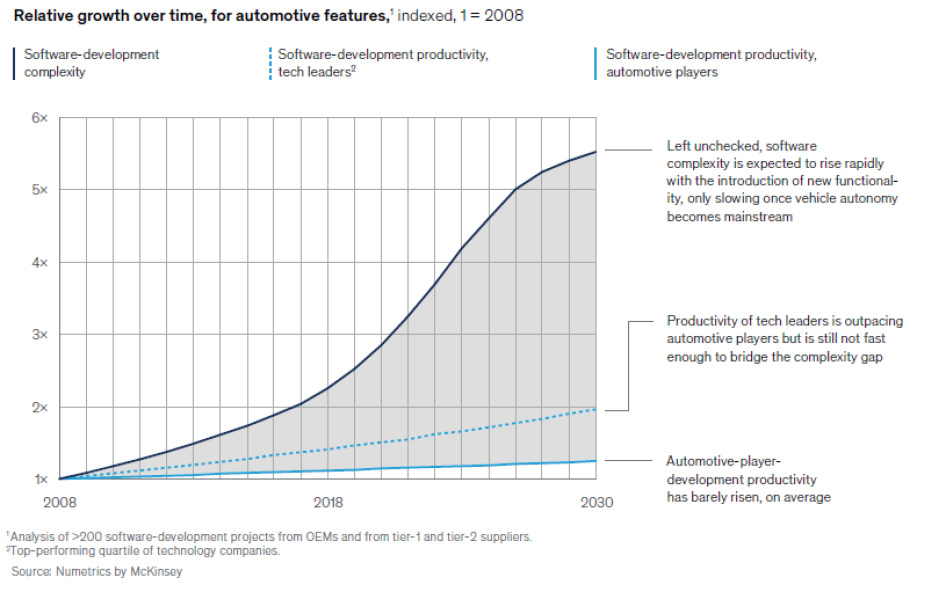
Ultimately, an end-to-end software platform, consisting of a an operating system and a middleware layer with standardized interfaces abstracting the hardware layer for the application and function software layer is strongly needed to be able to manage the rising software complexity and to develop future vehicles in an effective and efficient manner. Software should be truly integrated end-to-end, software modules should be developed on a common code base, and a primary robust operating system should be able to cover all major systems throughout the vehicle.
- Development of a scalable, cloud-capable, and modular target architecture that supports decoupling of hardware and software and features a strong middleware layer (see illustrative example below). The target platform (middleware) to be developed needs to support current and future operating systems (proprietary, open-source) and also different E/E architectures (domain-oriented, zone-oriented, etc.).
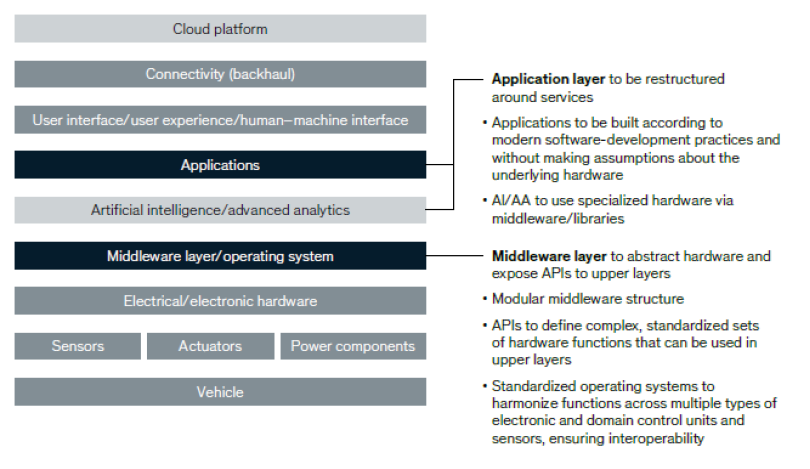
- Development of a neutral SDK (cf. the smartphone world before and after the iPhone of 2007) which allows any software application developer to develop and test independently of hardware and operating system.
- Abstraction of the complexity of underlying hardware, middleware, kernel, interfaces, and drivers into simple to use and to re-use, robust, safe&secure APIs.
- Support of safety and security according to automotive standards (safety-criticality is the main difference to the smartphone and consumer electronics market).
- New software development methodologies (e.g., agile-at-scale).
- Eventually, the targeted software platform should basically fulfil and feature:
- ROS1 and ROS2 compatibility.
- Hardware SOC abstraction, runs on x86 and ARM.
- freedom of choice of SOC.
- Middleware abstraction, simplifies the use of complex middleware interfaces.
- Hard real-time execution and real-time logging of data.
- Fully deterministic software execution.
- System safety enabled through managed nodes with lifecycle management.
- System security through process-level security, encryption, authentication.
- Support for automotive hardware, i.e., ECUs and automotive sensors.
- Functional safety certification (ISO 26262, SEooC, up to ASIL D).
- Appropriate testing methods, e.g., condition coverage or integration tests.
- Development environment, tools, toolchains.
- Complete and integrated solution for both intra- and inter-ECU communication.
- Integration of common frameworks such as AUTOSAR, Apex.OS and others.
- Simple to integrate into custom frameworks.
- Support for today's most relevant protocols for automotive ethernet.
- Capable to handle large amounts of data efficiently.
- High-performance communication with low runtime consumption.
- Ensuring compatibility to SIMPL150 (cloud-to-edge federations and data spaces made simple). SIMPL is the smart middleware that will enable cloud-to-edge federations and support all major data initiatives funded by the European Commission, such as common European data spaces.
3.1.4.4 Major Challenge 4: Provide tools and methods for validation and certification of safety, security and comfort of embedded intelligence in mobility
To achieve the EU-wide goal of zero fatalities by 2050, active safety systems and automated vehicles are necessary (the term “vehicle” here covers mobility systems on land, water and in the air: cars, trains, ships and airplanes). Although several technology demonstrators for highly automated vehicles already exist, there is a severe lack of cost-effective, commonly accepted verification & validation (V&V) methods and tools. Winner et al151 predict that more than 400 million km of road driving would be required to statistically prove that an automated vehicle is as safe as a manually driven one, implying that a proven- in-use certification by performing physical tests on the road is no longer feasible. This lack of effectively applicable V&V methods has created a major barrier for the market introduction of these systems. The development and use of Digital Twins is becoming a cornerstone for future development and updates of this type of complex automated systems, interacting with the cloud. Meanwhile many experts in Europe as well as in many other countries of the world work together under the guidance of UN/ECE to create standards for the approval of ADAS and AD functions in mobility. The draft of the Regulation (EU) 2019/2144 for ADAS function is approved and contains definitions for the expected functionality of many ADAS functions as well as first indications how to prove them. The associated ADAS and AD functions are Lane Departure Warning System, Advanced Emergency Braking on Heavy Duty Vehicles, Speed Limitation Devices, Reversing Detection, Pedestrian and Cyclist Collision Warning, Blind Spot Information System, Emergency Lane Keeping System, Advanced Emergency Braking on Light Duty Vehicles, Protection of Vehicles against Cyber Attack, Intelligent Speed Assistance, Emergency Stop Signal, Alcohol Interlock Installation Facilitation, Driver Drowsiness and Attention Warning, Driver Availability Monitoring System, Event Data Recorder, Systems to replace driver's control; Systems to provide the vehicle with information on state of vehicle surrounding area and Platooning.
The main challenge is the tight interaction of these safety-critical automated systems with their environment. These interactions get more complex the higher the automation level gets. This means that not only does the correct functioning of the automated cyber-physical mobility system itself need be tested, but also its correct reaction to the behaviour and specifics of its surroundings. This leads to a huge number of potential scenarios that every automated mobility solution will have to handle in a safe way. It is important to take into account not only the commonly occurring scenarios encountered by the mobility systems as vehicles, trucks, airplanes, ships et al, but also the occurrence of safety critical events during these scenarios. Many of these safety critical events fortunately do occur only seldom, but that makes it even more difficult to test the correct reactions of the automation systems in these situations. ![]()
![]()
Many highly automated cyber-physical systems have adopted machine learning (ML) and AI to enable autonomous decision-making and render applications smart. While the use of ML and AI components offers great promise for improving our everyday lives in many, sometimes unimaginable, ways, it also brings a host of very difficult verification, validation and certification challenges in the context of safety- critical applications. The opacity of ML/AI components requires the development of completely new V&V techniques, and to accordingly extend existing V&V methodologies. It is important to not only secure stable solutions based on ML, but also how to exploit increased learning based on new data, and to update existing vehicles with updated algorithms using the additional learning from new data, while guaranteeing no side-effects. ![]()
![]()
![]()
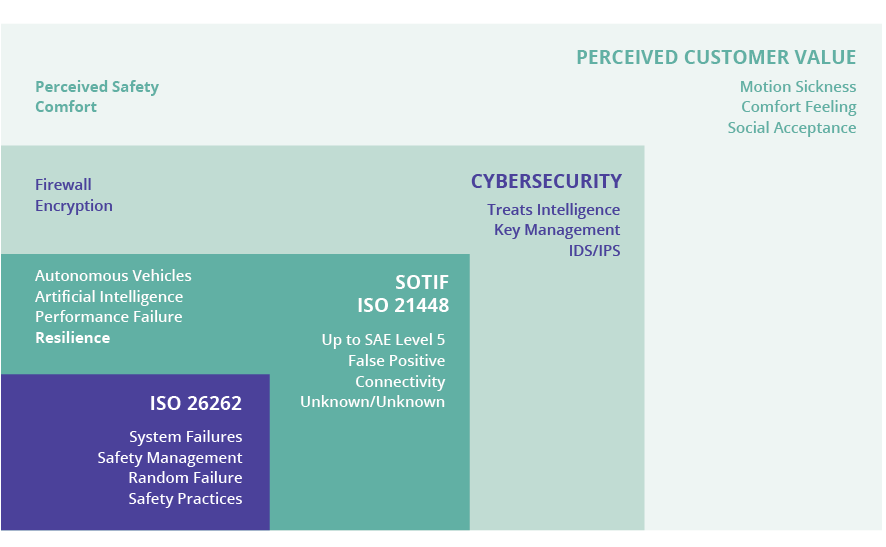
Modern highly automated cyber-physical systems increasingly dynamically evolve after their deployment, and OTA updates and upgrades are becoming necessary in such systems. New methods and tools for these updates and upgrades, together with the respective re-verification and re-certification approaches, are necessary to avoid negative impacts on both safety and security.
Automation functions of vehicles rely on environment sensors, such as cameras, lidar, radar and ultrasonic sensors, as well as communication to other vehicles or infrastructures. As these safety- relevant components may degrade over time or be exposed to cyber-threats, accelerated reliability and cybersecurity test methods are required. This will need further diagnostic devices to check the reliability of hardware, sensors and their software.
The role of the driver and any additional passengers in an automated vehicle is completely changing, and therefore new test methods and tools are necessary to ensure comfort and perceived safety (societal acceptance). These are already in the early development phases in terms of new functionality and their safety.
Many of the above issues are mentioned in existing or upcoming automotive standards for cyber-physical systems – for example, Safety of Intended Functionality (SOTIF), ISO 26262 and UL4600 (see ). As none of these standards are mature enough to certify fully automated vehicles with reasonable effort, close cooperation between the standardisation committees and the research consortia will be necessary.
The expected outcome is twofold:
- Digital innovation to increase road safety as specified in the CCAM programme: reduce the number of road fatalities and accidents caused by human errors to zero by 2050, as well as ensuring that no additional road fatalities are introduced by automated transport.
- Reduce validation costs down from the current two-to-five times of the implementation of automation functions in mobility by 60–80%.
To ensure the safety, security and comfort of automated mobility systems consisting of embedded AI-based software, sensors and actuators, as well as processing platforms in vehicles, ships, trains, airplanes and off- road vehicles, several verification, validation and certification toolchains are necessary. These should ensure the safety, reliability, security and comfort for passengers and the surrounding traffic participants based on costs that do not exceed those of the design and implementation of the following functions:
- Verification of components of automated mobility systems as environment sensors/ communication systems, perception systems, environment awareness, route planning and actuator systems, diagnostics devices and black-box monitoring systems. A special case here is the use of consumer-grade components in vehicle automation. Test concepts and tools have to be developed on several levels:

- Perception system tests focusing on an adequate functionality of sensors and the fusion of several sensor inputs.
- Manouver planning route decision and track control systems testing.
- Complete automated vehicle, airplane ship et al in the defined operating environments (ODDs).
- Correct and secure communication with other traffic participants and/or traffic operators.
- Validation of complete automated vehicles to perform safely and securely, and to provide comfort for passengers as well as other traffic participants in the specified operation design domain (geolocation area, weather conditions, road/sea/air conditions, etc.).
- Validation of the reliability of all components as well as their interaction as a complete automated cyber-physical system in the specified operation period.
- Validation of the safety, security, reliability and comfort for the deployment of OTA update packages for automated on-road or off-road vehicles, trains, ships and airplanes.
- Verification of the completeness and reliability of training datasets for machine-learning and AI algorithms used in automated cyber-physical systems.
- Validation of the accuracy of simulation models in the specified operational design domain (ODD) used in virtual validation toolchains.
- Development of Digital Twins (for example for vehicles, trucks, drones, ships, airplanes, sensors, pedestrians, environment etc.) for validation of new concepts, verification of car2cloud interactions and preparation of updates of automated vehicles.
Validation toolchains, their components and underlying methods should lead to safe, reliable and secure argumentation describing why the performed tests resulted in the estimated residual risk for automated cyber-physical systems for on-road or off-road vehicles, ships, trains and airplanes. Optimisation methods can be used to balance multiple design objectives – e.g. that the residual risk remains below a certain limit (such as that stipulated by regulatory bodies) while meeting financial design targets. The verification, validation and certification tools and methods may be used for cyber-physical systems with different levels of automation.
A special focus is on the verification, validation and certification of embedded AI-based systems, and the required training data for the respective machine-learning algorithms. Ecosystems for the creation and maintenance of reliable labelled data are envisioned. To integrate with different legacy systems, eco-systems supporting open platforms are required. ![]()
![]()
Virtual validation, or more concretely scenario-based virtual validation, is considered a cornerstone for the verification, validation and certification of vehicles. Two aspects are essential here: (i) scenarios representing the most relevant situations; and (ii) reliable simulation models.
Scenarios may be derived from requirements of safety analyses, extracted from naturalistic driving or synthetically created using gaming theory-based methods with a defined relevance. Statistical safety evidence from scenario-based verification and validation derived from naturalistic driving is needed. Also, here the establishment for open platforms and ecosystems for the creation and maintenance of reliable scenarios is encouraged. The definition of performance (safety, security, reliability and comfort) indicators for different automation functions and SAE levels (in the case of road vehicles) is necessary. Again, eco systems to share these data are useful.
Reliable simulation models for environmental sensors, vehicles, drivers and traffic participants, as well as traffic, are vital. The development of these models, and the corresponding test systems, are essential. To test safety-critical scenarios using real vehicles in a safe environment requires the creation of stimulators for the different environmental sensors under different weather, traffic and road conditions. The verification, validation and certification of vehicles will be carried out with a combination of virtual test environments using model-in-the-loop (MIL) and software-in-the-loop (SIL) in the cloud with massive parallel processing in order to allow for testing of very high numbers of scenarios in combination with different critical events and varying ODD conditions as sun, rain, fog, snow etc., mixed virtual/real environments (vehicle-in-the-loop, VIL, and hardware-in-the-loop, HIL), as well as a proving ground for real-world public road testing. Road testing will result in amounts of data larger than 20TB per hour per vehicle, and therefore adequate data acquisition, management and (cloud or on-premise) evaluation systems capable of handling the specific data types of the sensors are critical (although these do not exist yet). Additionally, OTA data collection from in-use operations is required to continuously collect unknown scenarios that can be fed back into development to improve the quality of the systems. ![]()
![]()
Additional challenges covering this topic can also be found in Chapter 2.3 (Architecture and Design: Methods and Tools) and Chapter 2.4 (Quality, Reliability, Safety and Cybersecurity) of this SRIA.
3.1.4.5 Major Challenge 5: Achieve real-time data handling for multimodal mobility and related services
To help provide better health and quality of life for their citizens, European municipalities will continue to ban cars with conventional powertrains from city centres, and promote more equal urban land use. At the same time, the demand for individual accessibility, flexible transit and fast delivery is on the increase. Therefore, multimodality is a cornerstone of the EU’s strategy on transport. This combines collective and individual solutions, ranging from micro-mobility such as e-scooters via car-sharing and ride-pooling fight up to long-haul transport systems through common hubs, platforms and systems for booking, customer services and payment. In the future, Europe will also aim to offer more sustainable and systemic transport solutions besides road transport, such as high-speed rail or electric aircraft. Concurrently, limited peak capacities, missing last-mile connections and self-contained mobility-as-a- service systems will remain somewhat of a bottleneck when it comes to shortening travelling times, keeping supply chains clocked, and reducing single occupancy trips, with the accompanying reductions in congestion, environmental concerns and cost of travel. Therefore, sharing services are the key element to maximising the flexibility of public transport systems, and new technologies such as taxi and delivery drones or guided transport (hyperloop) solutions can be expected to fill the gaps in the time, cost and green environment map.
Recent events such as the Covid-19 pandemic but also natural disasters have put some elements of this quite systemic future vision in question. Public transport, as the cornerstone of a multimodal mobility system, is particularly affected as the desire for readily available, trustworthily hygienic and health-protecting ways of getting from A to B became paramount. And, highly connected and infrastructure-based mobility solutions show limited resilience against flooding and wildfires. It will remain a challenge for mobility service providers to develop and deploy novel solutions, such as self-sanitising and protective mobility shells (physical or virtual), for a vulnerable society that combine the flexibility of a multimodal system with the required infection safety and provide a CO2 and emission neutral mobility at the same time. The same applies to make autarkic heavy vehicles and machinery for rescue and clean-up operations zero-emission. In another sense, multimodal mobility could also mean putting services and deliveries on wheels, which so far would have required people to travel to places where they risk being exposed to the virus. And, having robotic functionality, ad-hoc networking capabilities and a battery as mobile electricity source on a tractor might provide just the right level of resilience that will be needed future emergencies, and make full use of the opportunities of automation, connectivity and electrification in a new way.
As pointed out by the EU-funded Coordination and Support Action “Action Plan for the Future of Mobility in Europe”152, the vision of a truly integrated and seamless transport system for people and freight must be developed and implemented, and the full potential of transformative technologies has to be exploited. This can only be achieved if user-centredness, cross-modality and technology transfer become the focus of efforts for all stakeholders in transport.
- Design a low/zero emission, safe and accessible transport system tailored to user needs by exploring user needs and expectations, defining user profiles and mobility patterns, and identifying technology options.
- Enable mobility everywhere for everyone through the technological development of, for example, sensors, AI, machine learning, predictive maintenance, safe and secure vehicle software and electronics.

- Enhance efficiency and capacity in rail projects for automated maintenance and transfer of goods between modes.
- Create intelligent decision-support systems for passengers and transport operators that enable smart travel demand management.
- Achieve real-time data handling for multimodal mobility and related services.
- Develop convenient sharing concepts through automated maintenance of vehicles, and define approaches for implementation.
- Develop a framework for cybersecurity in passenger and goods transport across all modes, and provide IT connectivity that allows plug and play data sharing.
- Increase data security and privacy in authentication and payment processes for mobility services (through the concepts of trustee roles, blockchain, etc.), and support the respective initiatives.


- Employ robots, drones and shared public transport services for logistics.
- Infection-risk detection, self-sanitising and protective functions for public transport use.
- Multimodal navigation systems providing travellers with efficient, safe and healthy transfer options.
- Development of modular mobility platforms for the on-site provision of services and goods delivery.
- Integrate cross-modal hubs and interfaces into the urban structure, and connect them by harmonised infrastructure to smart sustainable corridors.


- Provide open application programming interfaces (APIs) and user data and statistics for all modes and providers, enabling demand-oriented and demand-responsive cross-modal transport offers.
- Ensure accessibility of shared services, and incentivise shared fleets of personal mobility devices at hubs to facilitate mode change for those with disabilities and reduced mobility.
- Hygienic and individualized mobility shells for demand-responsive transportation means.
- Make vehicles and transportation systems more resilient by smart application of automation, connectivity and electrification .
In addition to the availability of technology, components and systems as described in other parts of this document, it is important that a number of societal needs are met, particularly the following:
- Legislation for automated vehicles throughout Europe: some initial pilot sites have been identified, but an overall legislative framework is required to achieve full deployment of highly automated driving (HAD). To date, there has been no regulatory approach to define a security/ privacy framework for the IoT that involves billions of identities and devices being connected with each other. Technological stakeholders and the political arena have to share findings and derive recommendations to EU’s and national regulatory bodies concerning the minimal regulatory framework needed to assure the security and privacy of citizens and companies.
- Social acceptance of the technology by citizens and users: society (governments, media, press, citizens, educational institutes, etc.) has to be prepared for the introduction of some of this technology (such as by human factor-based questionnaires) and their thinking monitored to help define what actions can be taken on how new technologies and related services can be more easily accepted.
- It is crucial that future systems meet the expectations of end users, and that their underlying technology and platforms can be operated by service providers with appropriate business models; end users will expect flexible, reliable and cost-efficient services that can be personalised for them. For both end users and service providers, GDPR compliance is essential to ensure maximum transparency and user acceptance.
Some examples of attention areas are:
- Evolving from regional/national policies to a European-wide supported common policy with respect to HAD.
- Evolving from regional/national pilot test sites to European-wide deployment.
- Ensuring privacy protection in connected cars, and how this should be communicated to citizens.
- Ensuring business perspectives for MaaS operators, seamless mobility to end users and the reduction of emissions and urban congestion.
The roadmap for the key digital technologies in mobility are aligned with European roadmaps for terrestrial, water and aerospace transport:
- A new European Road Transport Research Advisory Council (ERTRAC) roadmap entitled "Sustainable Energies and Powertrains for Road Transport – Towards Electrification and other Renewable Energy Carriers”.
- Urban mobility roadmap.
- Long-distance freight transport roadmap.
- Towards zero logistics emissions by 2050.
- The joint European Technology Platform (ETP) common paper published in 2019.
- The European roadmap on connected and automated driving published in 2019.
- The Joint Strategic Research Innovation and Deployment Agenda (SRIDA) for the AI, Data and Robotics Partnership (euROBOTICS), September 2020.
The roadmap combines the objectives in the application research programmes 2Zero and CAM with the derived KDT mobility challenges. The following roadmap indicates when R&D&l activities are required to ensure the key digital technologies are available for use in the different mobility domains. In areas that already have ongoing electric mobility, the focus is more on improvements to existing concepts (for example, optimisation of costs), while for others (such as electric aircrafts) it is more about focusing on lower technology readiness levels (TRLs). These are both going on in parallel, and are also influencing each other.
This roadmap is a preliminary estimate in regard to when ESBS (electronic and software based systems) will need to be ready for the various technology fields. It will be continuously updated as new domain roadmaps become available.
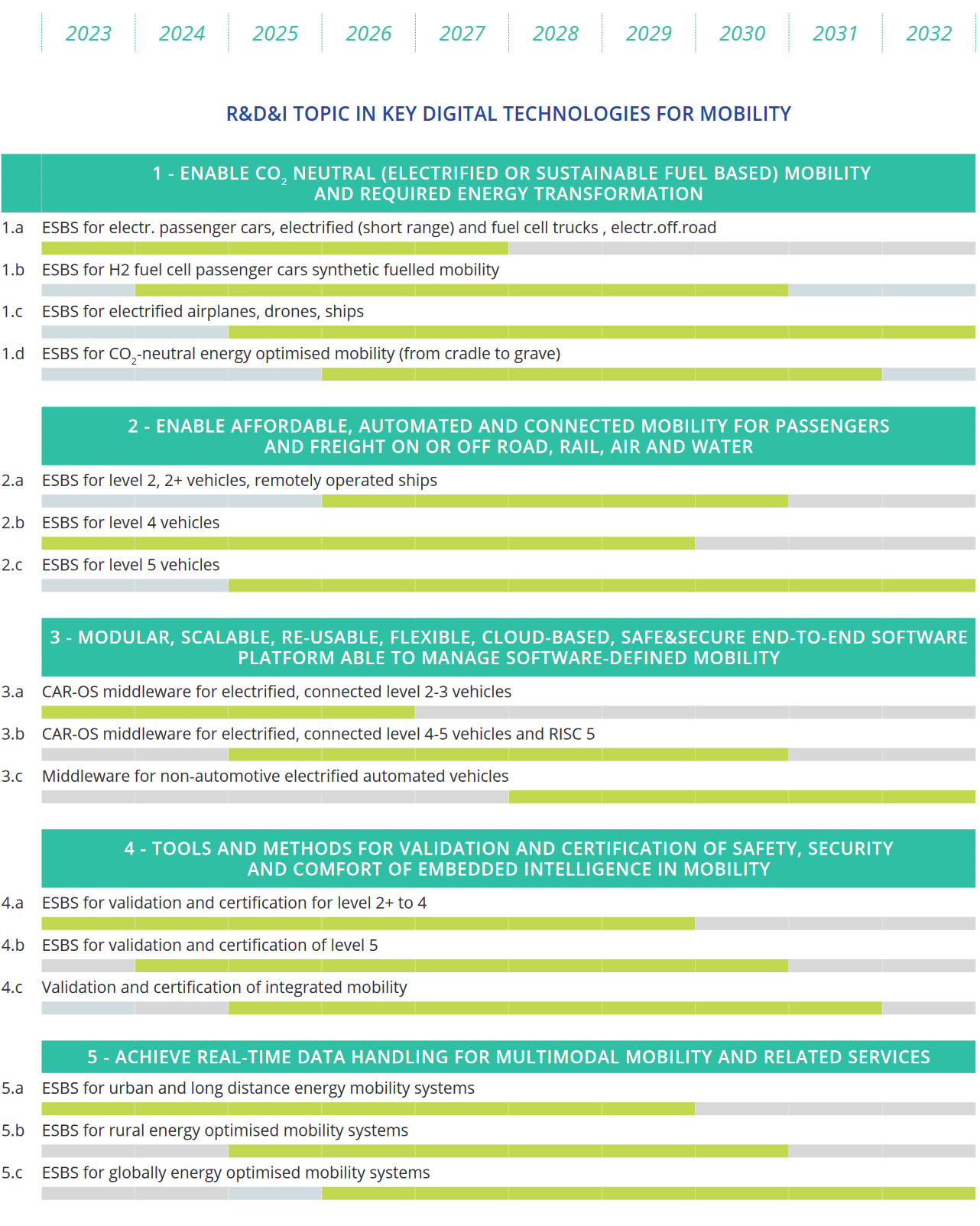
Mobility is a domain that needs multiple key enablers, as described in other Chapters of this document. It is transversal to almost all chapters, from components to systems.
For instance, semiconductor technologies are evolving rapidly. In the past, silicon was the dominant material, but its performance is now being outpaced by wideband materials such as SiC and GaN. These materials allow reduced packaging, increased operation temperatures, higher switching frequencies and therefore new concepts of compact power electronics modules. This is a major disruption that changes the market for electric mobility.
Closely linked to these semiconductor technology updates are packaging technologies. Moving from standard industrial modules to full heterogeneous integration is the second major disruption. Only adapted packaging can permit the full exploitation of the benefits of such new semiconductor technologies. ![]()
![]()
Other components that are of strategic importance are passives, such as capacitors and coils that can withstand higher temperatures and switching frequencies. For these, it is necessary to look at innovative materials that bring improved performance at a lower cost and a high rate of recyclability for the whole system.
The convergence of the automotive and energy eco-system for bidirectional charging and also in future the usage of cars as producers of electrical energy for the grid requires a close cooperation of the activities in Chapter 3.2. ![]()
A further aspect of mobility is the increasing level of automation, which is also having a huge influence on other in-vehicle components in the area of digital technologies for embedded software, AI, sensors, actuators and trustworthy communication. In this respect, there is a strong need for cybersecurity to protect cars, drivers and the environment. Remote access and OTA updates of rapidly improving complex software for the upgrade of car systems are therefore mandatory. This requires a safe, secure and available infrastructure in cities as well as rural areas. ![]()
![]()
![]()
![]()
This infrastructure includes 5G/6G communication to allow massive transfer of data to and from cars, which can be considered as “data-centers on wheels”. In the background of such operations, a performant (and GDPR-compliant) cloud data system needs to support the mobility of each individual. The overall management of such an infrastructure should include smart grid operations to minimise energy waste and losses through inefficiencies, as is further elaborated upon in the Energy Chapter. It is clear that this requires system developments, from small sensor systems to micro and large grid control, including all aspects of cohabitation of modules and sub-systems. (electro- magnetic compatibility, EMC, and thermal considerations). ![]()
![]()
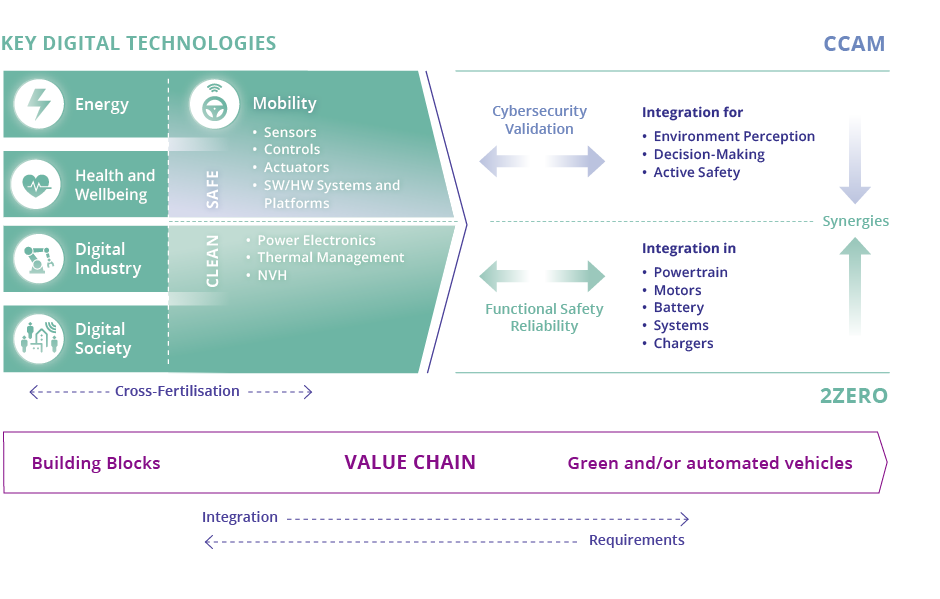
It should also be noted that synergy potentials exist between the domains of safe and clean mobility, not just at the level of the application in a multimodal urban mobility system but also at the level of the enabling technologies. Examples include electronic architectures for fail-safe power distribution and control within the vehicle, the functional safety and reliability of systems and cybersecurity, and control in power systems. Additional alignment is already in progress with existing or planned programmes for rail (Transforming Europe’s Rail System), maritime (Zero Emission Waterborne Transport) and aerospace (Clean Aviation).
146 Internal Market, Industry, Entrepreneurship and SMEs, https://ec.europa.eu/growth/sectors/automotive_en
147 “Internal Market, Industry, Entrepreneurship and SMEs” (available at https://ec.europa.eu/growth/sectors/automotive_en)
148 Sources Goldstein Research “Smart Healthcare“, 2018; International Energy Agency ”Energy Efficiency“, 2017; Frost & Sullivan ”European Smart Grid“, 2016; Bloomberg New Energy Finance “Global storage market“, 2017, IHS “Smart Grid Sensors“, 2015; BIS Research “Global augmented and virtual reality”, 2016; Gartner (IoT) 2017; MGI “The Internet of Things: mapping the value beyond the hype”, 2015.
150 https://digital-strategy.ec.europa.eu/en/news/simpl-cloud-edge-federations-and-data-spaces-made-simple
151 Winner, H.; Wachenfeld, W.; Junietz, P.; Winner, H.; Prokop, G.; Maurer, M. (eds.) (2018): Validation and Introduction of Automated Driving. In: Automotive Systems Engineering II, pp. 177-196, Cham, Springer International Publishing, ISBN 978-3-319-61605-6
152 Mobility4EU, www.mobility4eu.eu
